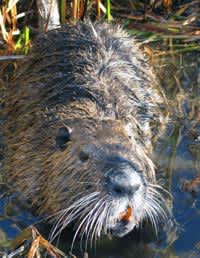First Invasive Nutria Population Since 2002 Confirmed in Delaware
OutdoorHub 01.22.12

Dover, DE – Following on a lead from an alert fur buyer, biologists with the U.S. Fish and Wildlife Service (USFWS) and U.S. Department of Agriculture’s APHIS Wildlife Services have confirmed the presence of an invasive nutria population on a pond near the town of Marydel, Delaware in the west central part of the state.
Nutria are South American semi-aquatic rodents similar to our native muskrat and beaver. Maryland’s nutria population was established when nutria escaped or were intentionally released from fur farms in the 1940s. The nutria’s destructive feeding habits have resulted in the loss of tens of thousands of acres of marsh to erosion throughout the Chesapeake Bay.
“The destruction that nutria have caused in the Chesapeake Watershed is tremendous. The Division of Fish and Wildlife is committed to ensuring similar destruction does not occur in Delaware,” said Joe Rogerson, Deer and Furbearer Biologist with the Delaware Department of Natural Resources and Environmental Control (DNREC), Division of Fish & Wildlife. “Early detection and a rapid response will be critical in protecting our valuable wetland resource. The Division will be working closely with USDA APHIS Wildlife Services to develop a scientifically-acceptable and appropriate removal strategy for Delaware.”
The Chesapeake Bay Nutria Eradication Project (CBNEP) seeks to remove invasive nutria from the Delmarva Peninsula. The project is a partnership of more than two dozen federal and state agencies and institutions along with private landowners, with the USDA handling field operations and investigating nutria sightings reported by the public. The partnership has been successful in eliminating nutria from heavily-infested portions of the Blackwater, Transquaking, Chicamicomico, Nanticoke and Choptank Rivers as well as Fishing Bay, Deal Island and Ellis Bay Wildlife Management Areas.
The team is now turning its attention towards nutria that may have migrated into the headwaters of these rivers as well as other watersheds on the Delmarva Peninsula. Nutria populations have been confirmed in Wicomico, Manokin, and Big Annamessex Rivers. Although isolated reports of nutria have occurred, the recent discovery in Marydel is the first confirmed population in Delaware since the USDA team began operations in 2002.
A landowner adjacent to the Marydel pond reported that a family member had observed several nutria over the past three years, but did not know what the strange creature was. The fur buyer recognized a pelt as nutria and reported this to a USFWS biologist. USDA staff obtained permission from the landowners surrounding the pond to conduct a thorough inspection and found nutria signs throughout the pond, including droppings and damage to shoreline vegetation.
“Several important Chesapeake Bay rivers originate in Delaware. Although we’ve removed most of the nutria from the main stems of these rivers, finding isolated populations in the headwaters is the key to making sure the nutria don’t reinvade,” said Steve Kendrot, USDA’s Project Leader for the CBNEP. “With only 15 staff to cover the entire Delmarva Peninsula, reports like this from concerned private citizens are invaluable.”
“Eradication of nutria is crucial to preserving wetland habitat on the Delmarva Peninsula. We are working closely with the Delaware Department of Natural Resources and Environmental Control and other partners to accomplish this goal,” said Genevieve LaRouche, Supervisor for the Chesapeake Bay Field Office, U.S. Fish and Wildlife Service.
Residents of Maryland and Delaware can report nutria sightings to the Nuisance Wildlife Hotline at 1-877-463-6497. More information about nutria and efforts to remove them can be found at: Chesapeake Bay Nutria Eradication Project .

